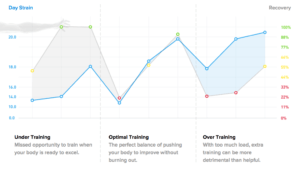WHOOP
Whoop uses heart rate variability to optimize training
Whoop
Whoop is a wearable band and data analytics platform for high performing athletes. By measuring heart rate variability, sleep and strain they have revolutionized sports medicine.
There are many competitors in the sports analytics space. The vast majority of these companies focus on measuring heart rate or some other metric to understand exercise or physical fitness. As an example, this may mean measuring steps or other movements through the accelerometer.
 Whoop sees these data sets as incomplete. How can you only measure output but not input? For whoop, the more accurate method is to measure both the strain and the recovery of an athlete. By forming a holistic picture of the athlete’s rest and intensity, whoop takes a long term view of an athletes training. This provides feedback on how and when to train hard, versus encouraging the same output every day.
Whoop sees these data sets as incomplete. How can you only measure output but not input? For whoop, the more accurate method is to measure both the strain and the recovery of an athlete. By forming a holistic picture of the athlete’s rest and intensity, whoop takes a long term view of an athletes training. This provides feedback on how and when to train hard, versus encouraging the same output every day.
The athletes experience with whoop is the following:
- Wear whoop band 24 / 7
- Workout as normal, while the whoop band automatically collects data on the strain you put on
- Sleep at night, while the whoop band measures the variability in your heart rate and pairs that with sleep data to create a recovery score
- Wake up and review recovery score which informs how much strain you should take on during that day
- Back to workout
There are a few main ways that this data can revolutionize sports:
Individualized Rest
Football is a great example of a sport where there is significant time between games. Because of this there is a lot of training that goes on during the week to prepare. Teams understand that you must be rested to perform. So, they taper the intensity of a workout before the game. However, every athlete recovers differently. Some people need more time than others. Your diet, sleeping habits, and more all effect your individual recovery needs. Teams are using the whoop band data to allow players to rest based on their personal schedules.
Preventative Rest
By evaluating not only how hard you work but how well you rest, the whoop band is providing data on when too much work may lead to injury. The data has been able to flag a pitcher who would have an injury or miss games because of a lack of rest.
In-Game Decision Making
In the future, the hope is that the data on an athlete’s need for rest or ability to take on strain can be used in real time. Substituting players mid game, or even informing play calling based on the status of a player.
Now… I could go into the background of why heart rate variability is a special data point, and hard to measure. But, I will simply leave you with this if you are really interested: https://www.ncbi.nlm.nih.gov/pmc/articles/PMC4213373/



Great post, A2017. This is an interesting company, and an interesting service. I think there is a clear analog here to FitBit, which tracks and interprets physiological data using wearable technology. FitBit has encountered lots of competitive pressure because its technology, and the algorithms that it runs, are simply not that difficult to replicate. Do you think that Whoop will run into a similar situation here? I would think that you only need a threshold number of users (maybe 1,000?), before your algorithms are – from the perspective of the user – just as good as the next guy’s.